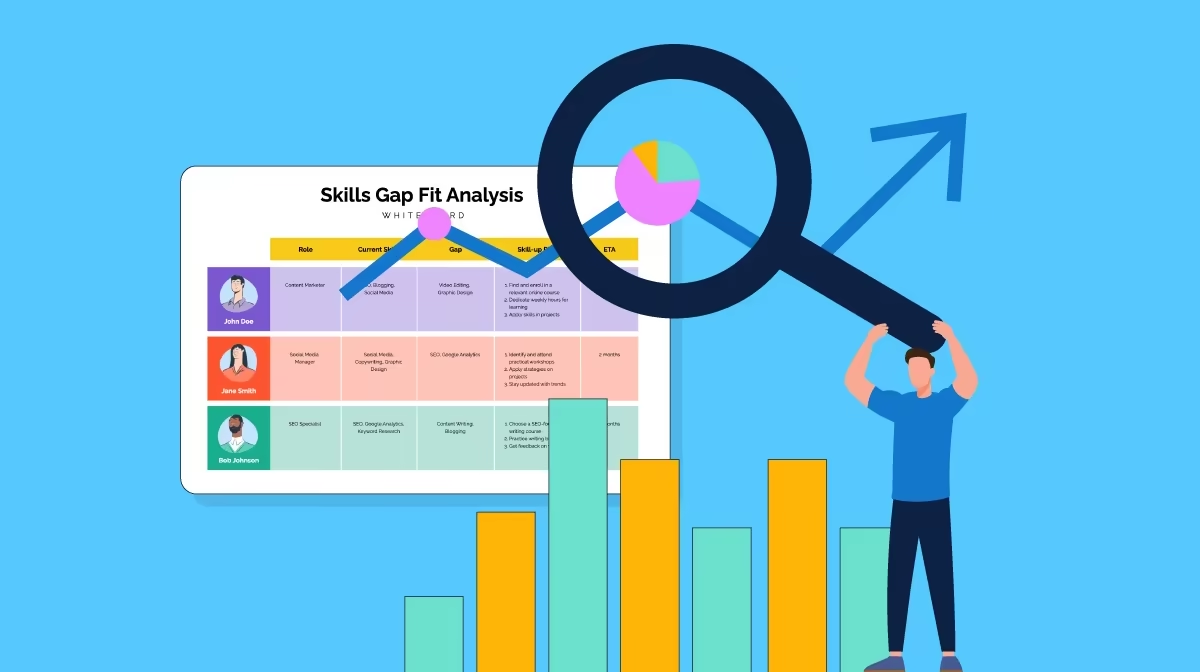More than a catchy HR slogan, up‑ and reskilling have become existential for modern organizations. Across industries, the distance between what teams know today and what they must know tomorrow widens so quickly that annual training plans feel out‑of‑date the moment they are signed. Business models now pivot on data, automation and AI; yet most employees were trained for an analogue world. This article offers a practical, 12‑month roadmap—tested in L&D teams from fintech to fast‑moving consumer goods—for turning a blurry "skills gap" into a precise, actionable skills map that guides every learning investment.
The Skills Gap, by the Numbers
- 59 % of today’s workers will need formal up‑ or reskilling by 2030, and 63 % of employers cite skills gaps as their top barrier to transformation (World Economic Forum, 2025).
- 87 % of companies worldwide acknowledge they already face—or will soon face—a skills gap (McKinsey, 2025).
- Nearly 70 % of HR professionals report an internal skills gap, up from 55 % just two years earlier (Wiley, 2023 survey).
- 86 % of business leaders say data literacy is now “day‑to‑day critical” for their teams, and 62 % say the same for AI literacy (DataCamp, 2024).
- Employers estimate that 44 % of workers’ current skills will be disrupted within the next five years (iMocha digest, 2025).
Taken together, these figures paint an unmistakable picture: HR can no longer rely on ad‑hoc course catalogues. The solution begins with clarity—mapping the skills that matter most and aligning learning paths to real business goals.
Phase 1: Map Mission‑Critical Data & AI Skills (Months 1–2)
- Start with strategy, not job titles. Meet with line‑of‑business leaders and ask a single question: “Which decisions will depend on data or AI in the next 12 months?” Their answers reveal the workflows—customer analytics, automated credit scoring, predictive maintenance—that drive value.
- List the capabilities, then link them to roles. Instead of “need a data scientist,” break capabilities into verbs: collect, clean, analyse, visualise, automate. Map each verb to existing roles or future roles you plan to hire.
- Prioritise by risk and opportunity. Use a simple 2×2 grid (impact vs urgency) to spotlight the first wave of upskilling targets.
Why it matters: When you map skills to strategic objectives, budget conversations become investment talks, not cost debates.
Phase 2: Diagnose Current Capability with Evidence (Months 3–4)
Knowledge is the easiest thing to overestimate. Conduct baseline assessments—internal quizzes, vendor platforms, even peer code reviews—to make hidden gaps visible.
- Benchmark with external data. The Wiley 2023 survey shows how quickly perceptions can shift: a 15‑point jump in reported skills gaps in just two years. Pair your internal results with industry benchmarks to create urgency.
- Measure both literacy and application. DataCamp’s 2024 report distinguishes between knowing the vocabulary of data/AI and applying it to live problems. Design assessments that test both.
- Share the findings widely. Transparency keeps the conversation solution‑focused rather than blame‑oriented.
Phase 3: Build a Future‑Back Skills Map (Months 5–6)
With a clear baseline, flip the timeline: imagine the company 24 months ahead and work backward.
- Define the North‑Star capabilities. Target competencies—say, “builds and deploys small‑scale predictive models”—not job credentials.
- Plot a progression path. Create learning stages (Foundation → Proficient → Fluent) for each capability. This visual map guides employees and managers alike.
- Stress‑test against disruption forecasts. Remember: employers expect 44 % of skills will be disrupted within five years (iMocha, 2025). Ensure your map is flexible; flag any capability likely to shift.
Partner with Accredited Online Universities for Turn‑Key Upskilling (Months 7–9)
Accreditation matters. It signals rigour, international transferability and long‑term value on an employee’s CV.
OPIT—The Open Institute of Technology offers modular, competency‑based bachelor’s and master’s degrees in Computer Science, AI, Data Science, Cybersecurity and Digital Business. The programmes blend theory with hands‑on projects and allow fast‑track options that slot neatly into corporate L&D calendars.
“When HR leaders plug employees into a curriculum designed around real‑world capstones, they get measurable output within months, not years,” says Lucas Tecchio, Head of Content Creation at OPIT.
How to integrate OPIT into your plan
- Match OPIT’s modules to the stages on your skills map.
- Use its progressive assessments to replace generic end‑of‑course exams.
- Leverage OPIT’s career services so employees can showcase projects internally.
Give Employees a Guided Orientation to Choose the Right Credential (Months 7–9, in parallel)
Choice overload kills momentum. Provide a curated pathway that still respects personal learning styles.
WeUni acts as a global orientation hub, letting learners filter 21 000 + accredited programmes by discipline, study mode and location in one interface.
“When employees can compare degrees by discipline, study mode and accreditation in one place, uptake jumps and mismatched enrolments plummet,” notes Andrea Pecetto, Chief Commercial Officer at WeUni.
Practical rollout tips
- Launch a microsite with the WeUni search embedded or linked.
- Provide managers with talking points so coaching conversations stay consistent.
- Offer stipend approvals within 48 hours to keep enthusiasm high.
Launch, Track, Iterate: The 12‑Month Sprint in Practice (Months 10–12)
- Set leading indicators first. Enrolments, module completion rates and project submissions create early wins.
- Link to lagging indicators. Track metrics such as reduced analytics backlog or faster time‑to‑insight.
- Run quarterly retros. Invite participants, managers and university partners; adjust the skills map and learning pathways based on real usage data.
Pitfalls
- Not every role needs a full degree. Blend micro‑credentials for peripheral skills.
- Budget constraints exist. Tie tuition reimbursements to project‑based milestones.
- Learning without context fails. Pair formal study with internal mentors who translate theory into day‑to‑day tools.
Conclusion: Skills Maps Beat Skills Gaps
HR’s mission is no longer simply to “close” skills gaps; it is to chart skills maps that evolve alongside strategy. By following the three‑phase framework—Map, Diagnose, Build—and partnering with accredited providers like OPIT and orientation hubs like WeUni, organisations can transform reactive training budgets into proactive talent‑building engines. Start by running your first mapping workshop next week. The business case is clear, the clock is ticking, and your future‑ready workforce is waiting.



